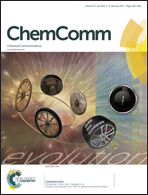Viable synthesis of highly compressible, ultra-light graphene–carbon nanotube composite aerogels without additional reductant and their applications for strain-sensitivity†
Abstract
A facile synthesis of three-dimensional ultra-light (≈2.52 mg cm−3) graphene–poly(dopamine) modified carbon nanotube composite aerogels that needed no additional reducing agents during the forming process is reported herein. The composite aerogels exhibited highly repeatable compressibility and superior electrical conductivity, and thus will have an important application value in strain-sensitive functional devices.


 Please wait while we load your content...
Please wait while we load your content...